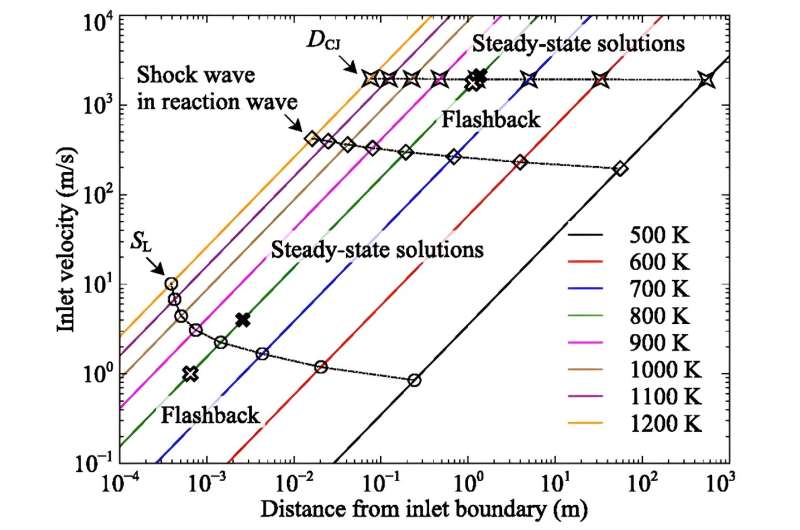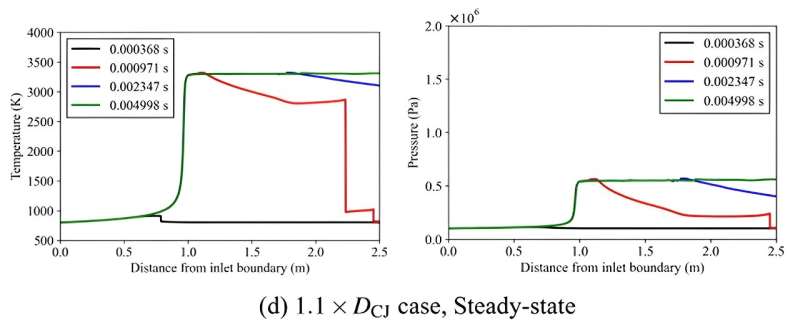This article has been reviewed according to Science X's editorial process and policies. Editors have highlighted the following attributes while ensuring the content's credibility:
fact-checked
peer-reviewed publication
trusted source
proofread
A theory linking ignition with flame provides roadmap to better combustion engines

In a study published on January 18, 2024 in the journal Physics of Fluids, researchers from Tohoku University theoretically linked ignition and deflagration in a combustion system, unlocking new configurations for stable, efficient combustion engines due to the possible existence of any number of steady-state solutions.
"This research directly tackles the challenge of reducing carbon dioxide emissions by enhancing the efficiency of combustion engines, a significant source of these emissions," said Youhi Morii from the Institute of Fluid Science at Tohoku University.
"A better understanding of combustion dynamics will also support the development of safer, more sustainable engineering solutions," said Kaoru Maruta, also from the Institute of Fluid Science.
Combustion dynamics involves complex coupled fluid and chemical reactions. Researchers use computational fluid dynamics to help them better understand and control the process.
If a system that operates stably in a steady state and has a certain tolerance range for small perturbations can be utilized, it would simplify the structure and control of combustors, and increase the feasibility of commercializing new combustor designs.
To explore this concept, the Tohoku University researchers considered a simple, one-dimensional reactive flow system, where unburned premixed gas enters a combustion chamber from the left inlet boundary, while burned gas, or deflagration wave, exits from the right outlet boundary.
The working theory up to this point held that a steady-state solution exists only when the inlet velocity matches either the velocity of the deflagration wave (which travels at subsonic speeds) or the velocity of the detonation wave—a shock reaction where the exiting flames travel at supersonic speeds.
However, this conventional wisdom is predicated on the assumption that chemical reactions in the preheating zone are negligible. Recent studies emphasize the significance of what's called "autoignition-assisted flames," wherein a deflagration propagating in a hot unburned premixed gas mixture has a faster propagation speed with the help of chemical reactions in front of the flame. This suggests that there are any number of steady-state solutions, which affect the amount of residence time gas stays in front of the deflagration.

Building on these findings, the Tohoku University researchers designed a theory that successfully bridged the gap between ignition and deflagration waves, revealing the existence of additional steady-state solutions that are possible when they considered the "autoignitive reaction wave"—a wave that is affected by ignition in the preheat zone but behaves like a deflagration wave.
"Contrary to the prevailing view that only a single steady-state solution exists for deflagration waves in subsonic one-dimensional systems, our approach posits an infinite number of such solutions as autoignitive reaction waves, asserting that ignition and flame are intrinsically linked," Morii said.
This means that steady-state solutions exist not merely at the two points where the inlet velocity matches the velocities of the deflagration or detonation waves, but also in a broader region if autoignitive conditions are considered.
The team further extended the theory to scenarios involving supersonic inlet velocities. In the supersonic regime, the conventional understanding is that a steady-state solution is possible only when the inlet velocity matches the detonation wave velocity. However, given that the autoignitive reaction wave originates from zero-dimensional ignition, the researchers argued that it should be independent of the inlet velocity.
"We propose that an infinite number of steady-state solutions exist for the autoignitive reaction wave, even in supersonic conditions," Morii said.
By theoretically linking ignition and flame, the engine can now be considered from a new perspective. Accounting for ignition phenomena offers the possibility of more stable combustion, leading to the idea of a new concept of engine that is more efficient than the conventional one.
"This work on stabilizing autoignitive reaction waves marks a fundamental breakthrough, potentially revolutionizing the design of combustion systems, especially in the realm of supersonic combustion," Morii said.
While theoretical and numerical results have provided a new engine concept, it has not yet been experimentally verified. The team, therefore, plans to apply the research findings to an actual engine through further experimental verification through joint research.
More information: Youhi Morii et al, General concept for autoignitive reaction wave covering from subsonic to supersonic regimes, Physics of Fluids (2024). DOI: 10.1063/5.0176262
Journal information: Physics of Fluids
Provided by Tohoku University





















